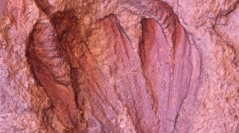

 Geodiversitas
40 (21) - Pages 521-527
Geodiversitas
40 (21) - Pages 521-527A sandstone slab bearing plant macro-remains was rediscovered during recent investigations led in the buildings of the old Musée Ignon-Fabre (Mende) which were closed in 1995 and emptied in 2003. The study of the slab clearly allows it to be identified as the holotype of Weltrichia fabrei Saporta, 1891 which has been considered destroyed since the end of the 20th Century. Gaston de Saporta described this Bennettitalean fructification based on a cast and considered the type locality as Rhaetian in age. In the present paper, based on the holotype, W. fabrei was revised in order to describe and illustrate the specimen in detail. It consists of a cup with one whorl of at least seven, slender and elongated sporophylls that apically curve inwards. Sporophylls display a dorsal median ridge, an acute apex and look leathery. Distally, the adaxial surface of sporophylls bears up to seven, elongated, tips forming branched structures comparable to the large pollen bearing organs observed among Upper Triassic/Lower Jurassic Bennettitalean fructifications. Here, the chronostratigraphic assignment of the type locality is discussed considering a Rhaetian?/early Hettangian age for the sandstone bearing W. fabrei. The depositional environment of W. fabrei was probably continental with a vast floodplain in which channels periodically occurred.
Bennettitalean, Williamsoniaceae, Early Jurassic, Causses Basin